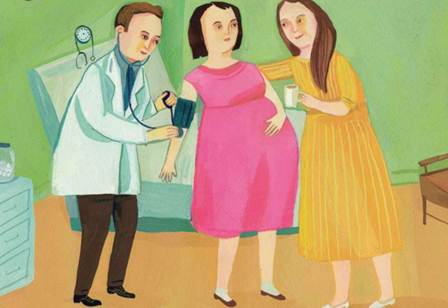A growing number of
OB-GYNs and midwives are partnering to provide care for moms-to-be.
When I found out I was pregnant, I
chose my OB-GYN for two reasons: She came highly recommended and I had heard through
other moms that she was supportive of natural childbirth. The fact that she
also shared her practice with a midwife didn’t play a part in my decision. At
the time, I thought you only needed a midwife if you were having a home birth.
I knew I was having my baby in a hospital, so what did I need a midwife for?

A
growing number of OB-GYNs and midwives are partnering to provide care for
moms-to-be.
As it turns out, the midwife in the
practice became an integral part of my pregnancy experience. I alternated
between my OB-GYN and midwife for each of my prenatal appointments and, by the
time I had packed my bag and mapped my route to the hospital, I no longer
differentiated between them: I viewed their individual skill sets as both
complementary and totally necessary.
What I’d stumbled upon was a collaborative
practice between an OB-GYN and a certified nurse midwife (C.N.M.) or certified
midwife (C.M.). Setups like it are becoming increasingly popular throughout the
United States as obstetricians and midwives hit what some experts are referring
to as the sweet spot in obstetrical care.
“Midwives are educated to ensure that women
own their bodies and make good decisions about their health and to provide
primary care to women across their lifespans,” says Elaine Germano, Dr.P.H.,
C.N.M., a Glenford, N.Y.-based midwife and senior education policy adviser for
the American College of Nurse Midwives in Silver Spring, Md. “OB-GYNs are
educated differently. They are surgeons and trained to heal the sick.” The idea
is that with both forms of expertise on your side, you’re covered, from natural
childbirth to emergency surgery and everything in between.
Recent research backs this up. A 2011 study
published in the journal Nursing Economic $ found fewer Cesarean sections,
lower rates of episiotomies and higher breastfeeding rates in practices that
include both midwives and OB-GYNs. The American College of Obstetricians and
Gynecologists and the American College of Nurse-Midwives issued a joint
statement of practice in 2011, suggesting that care is most effective when
practitioners work together. In addition, leading experts in obstetrics and
midwifery are collaborating on a series of papers supporting joint practice
scheduled for publication this fall in Obstetrics and Gynecology Clinics of
North America. According to Melissa Aveiy, a co-author of one of the papers
and chairwoman of the Child and Family Health Co-operative at the University of
Minnesota School of Nursing in Minneapolis, a joint practice allows you to maximize
your care with the support of two pregnancy and childbirth experts who can
provide the best care based on your individual needs. Some practices include
both midwives and OB-GYNs in the same office. In others, patients primarily see
a midwife and will see an OB-GYN if a complication arises.

Amongst
birth attendants, is an OBGYN truly the best and safest choice?
A collaborative practice that includes
surgical expertise and holistic know-how can mean a win-win for you and your
baby: f- Less waiting, more service You’ll still likely log time in a waiting
room, but seeing a doctor or midwife in joint practice can save you precious
minutes (or hours). “Most physicians feel rushed,” says Peter Weiss, M.D., an
OB-GYN in private practice in Beverly Hills, Calif., who shares an office with
a midwife. Weiss often divides his time between office hours, deliveries and
surgeries, but by partnering with a midwife, his patients can get more from
each appointment.
“A typical prenatal visit with a C.N.M. or
C.M. will include a health assessment and education about pregnancy,
nutrition, fitness, preparation for labor, as well as any factors in your life
that are contributing to your health and that of your baby,” says Holly Powell
Kennedy, Ph.D., C.N.M., first endowed chair of midwifery at Yale University and
president of the American College of Nurse-Midwives.
Natural childbirth is encouraged
“Midwives fundamentally believe that a
woman’s body knows what to do in labor and how to give birth,” says Michelle
Collins, Ph.D., C.N.M, assistant professor at Vanderbilt University School of
Nursing in Nashville, Tenn. In a collaborative practice, your midwife will be
spending the most time with you during labor—a boon for moms who want to go Au
naturel, but don’t want to give birth at home. In fact, 96 percent of births
attended by midwives happen in a hospital setting.

Natural
childbirth is encouraged
Midwives can help you manage pain by
suggesting helpful labor and delivery positions (squatting, swaying, etc.),
pain management techniques (breath work and imagery) and hydrotherapy (warm
showers and baths), as well as providing pain medication or ordering an
epidural, if needed.
You’re covered in an emergency
The majority of births go off without a
hitch, resulting in a healthy mom and healthy baby. However, if a complication
unexpectedly comes up, a collaborative practice means you have an OB-GYN—most
likely one you already know—at the ready.
As for my own birth, after three days of
laboring at home, I checked into the hospital. My midwife was supportive and
gave me the confidence I needed to endure such along labor. Together with my
OB-GYN, they encouraged me to push—so that’s just what I did. My son was born
healthy and well after four days of labor. If I’d had just one or the other on
my team, my birth experience might have been completely different. But, with
an OB-GYN and midwife in my corner, I was able to have the birth I’d hoped
for—knowing that no matter what came my way, we could handle it.